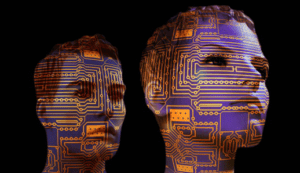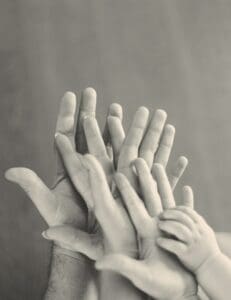Eudora Tucker long dreamed of owning her own fashion business, but ordinary expenses always stood in the way.
Now she can both pay her bills and design her line of sustainable clothing thanks to a cash-assistance program that puts an extra $200 in her pocket each month.
“Living in New York City, it’s always like, do I pay this bill? Or do I really invest in buying the materials I need for this one piece that I can sell?” said Tucker, who lives in Downtown Brooklyn with her son.
The program is administered by The Child Center of NY, a Queens-based nonprofit, and enrolls low-income New Yorkers who agree to meet with a cohort of other participants on a monthly basis. It launched last spring, fueled by a $1.5 million grant from the Phyllis Backer Foundation, in addition to a $450,000 grant from the William J. and Dorothy K. O’Neill Foundation.
It’s just one of an ever-expanding number of cash-assistance and guaranteed income programs being piloted nationwide, backed by both private and public resources, including tax credits. Some 38,000 people are enrolled in 100 pilot programs, according to a count by the Economic Security Project.
Gov. Kathy Hochul recently signed legislation that opens the door for a similar cash-assistance program for runaway and homeless youth. Most of these programs offer monthly grants ranging from a few hundred dollars to $1,000, either with “no strings attached” or obligating participants to meet certain requirements, such as enrolling in school or job training.
Research is still out on whether the initiatives achieve their overarching goals of stemming poverty over the long term, as well as which formula for distributing cash works best. But proponents point to some promising results. Participants say the programs have helped them afford basic necessities and stretch their budgets to pursue education opportunities and grow their careers.
By providing program participants with $200 grants each month, the Child Center aims to support low-income individuals in achieving their long-term goals, said CEO Traci Donnelly. Tucker is among 300 individuals and families participating in the effort. Proponents say even modest amounts of assistance can help clear obstacles for participants, such as childcare or transportation woes.
“If we want to change the trajectory of generational poverty, we have to do something bold and something different,” Donnelly said. “That’s what we’re trying to do here.”
The concept of putting mostly no-strings-attached money directly in the pockets of needy people each month gained popularity when 2020 presidential candidate Andrew Yang touted a “universal basic income initiative” during the Democratic Party primary. The idea then took off during the pandemic as many organizations looked for new, contact-free ways to support low-income people.
“It’s not just that you’re giving unfortunate people $200 a month,” Tucker said. “You’re also giving them the opportunity to achieve goals that maybe they didn’t realize they had.”
Participants in the Child Center’s program are tied to cohorts or small groups, which coalesce based on a shared location, language or interest. Some are based in public housing communities, while others are linked to other nonprofit organizations or community groups. Individuals and cohorts can also apply for additional grants for personal and community projects up to $5,000.
The organization determines eligibility for the program based on a variety of factors, including participants’ income and where they live. The initiative focuses on East Harlem and the Queens neighborhoods of Elmhurst, Corona and Far Rockaway. But don’t look to sign up now; organizers say the program is full and not taking new applications.
Proponents say more programs are likely to emerge from both the public and private sectors as the benefits come more clearly into focus.
The impact of cash
Amy Castro, co-founder of the University of Pennsylvania’s Center for Guaranteed Income Research, says the guiding principle behind cash-assistance and guaranteed income programs is that individuals know what’s best for themselves, and what kind of assistance they need most.
Critics say that giving people cash with no strings attached fosters waste and dependency, especially when the help disappears after a few years.
But Castro says the research so far indicates that the programs yield much greater benefits. A breakdown of spending in over 30 pilot programs shows that participants spent the largest share of guaranteed income dollars on retail sales and services, and many use the dollars to pay for childcare, education or other bills. The breakdown included bank account and debit card transactions, but not cash transactions, which accounted for 40% of spending.
Her team’s research has also shown that involvement in guaranteed income pilots can improve participants’ mental health, well-being, financial stability and ability to secure a job.
“The idea behind unconditional cash is that people are the experts on their own lives,” Castro said. “They ought to have the same set of self-determination and agency we extend to people higher on the income ladder.”
In one study of a concluded pilot program in Stockton, California, which gave 125 individuals $500 per month for two years, the extra cash meant that participants were able to pay back loans, cover unexpected and emergency expenses, and alleviate income volatility and strain across families. Anxiety and depression among the program’s participants also decreased and many of them were able to find full-time employment, according to the study.
“People have goals, dreams, and aspirations, and they are locked out of being able to take any steps towards them because they’ve been sort of stuck in poverty, or living paycheck to paycheck,” Castro said. “What the cash does is it gives people the agency to act on these goals that have been latent for a really, really long time.”
Castro and her team are currently overseeing 32 other experiments nationwide, which they hope will shed light on the factors that make cash assistance programs most beneficial for participants. The team is still examining questions such as how much money to give, how frequently it should be given, and how long the assistance should last.
“On the one hand, you can say it works, right, because poverty by definition is lack of cash,” Castro said. “But what’s unknown is how much money does it take to create change?”
Some cash-assistance programs, like the one at the Child Center, include help beyond cash. This “cash plus” model provides participants with money as long as they complete other steps, like setting goals or attending workshops or events, but it provokes skepticism from some researchers.
“Two things that kind of go together is that financial scarcity generates time scarcity,” Castro said. The more hoops participants have to jump through to get the cash, the less accessible and equitable programs may be, she added.
It’s an arena that still needs to be studied, according to Sidhya Balakrishnan, who directs guaranteed income research at the Manhattan-based Jain Family Institute.
“It’s not like you give everyone unconditional cash and it resolves all social problems, in New York or otherwise,” Balakrishnan said. Her team is investigating the question of how job training in addition to cash affects participants’ experiences during and after a guaranteed income program.
The long-term effects of guaranteed income programs have also yet to be determined, Balakrishnan said.
“Whether people increase their spending, whether they reduce their debt – we don’t know,” Balakrishnan said. “That’s why I think one thing which is extremely valuable about all these pilots is that they almost all have a research component, qualitative or quantitative.”
A ‘life-changing’ program
When the Child Center launched its program last year, two guaranteed income programs had already gotten off the ground in New York City. The Bridge Project, which launched in July 2021, provides low-income mothers with cash infusions of $500 or $1,000 each month for 36 months. Another program, Creatives Rebuild NYC, provides $1,000 monthly to city-based artists for 18 consecutive months.
Both programs say the cash they give participants comes with “no strings attached” – meaning that no mandatory meetings, training, or enrollment in other programs are necessary for participants to receive their monthly installments.
The reach of guaranteed income in New York state is poised to expand in the coming months as well. In December, Hochul signed a bill into law that will help propel the launch of a pilot program that will provide monthly cash transfers to 30 homeless youth. Researchers will then compare outcomes for this population against outcomes for runaway and homeless youth who are not provided with direct cash transfers. The bill ensures that the money youth receive in the pilot, and any similar research, does not disqualify them from other public-assistance benefits.
For Tucker, participating in the Child Center’s program has been “life-changing,” she said.
In addition to the monthly cash, Tucker has received aid to help launch her business, which has enabled her to buy a new sewing machine and create her legal business entity. She says the women in her cohort have served as an invaluable support system and sounding board.
But the cash from the program has mainly helped provide breathing room and space for her to consider long-term goals.
“It takes a lot of the pressure off,” said Tucker. “There have been months where I’ve used it for groceries or paying a bill, but for the most part I’ve used it to invest in my business.”




















